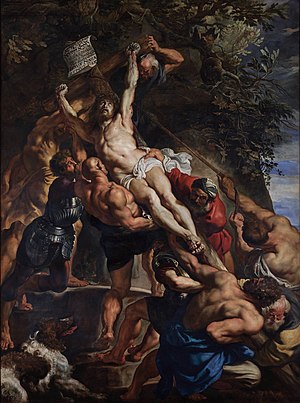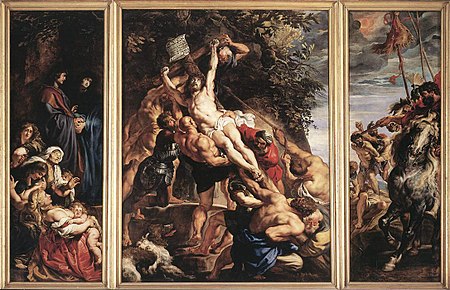Description
The Elevation of the Cross: central panel
The Elevation of the Cross altarpiece is a masterpiece of the Baroque period by the Flemish painter Peter Paul Rubens. The work was originally installed on the high altar of the Church of St. Walburga in Antwerp (since destroyed), and is now in the Cathedral of Our Lady in Antwerp.
Peter Paul Ruben's famous depiction of the raising of the cross was originally commissioned as an altarpiece for the church of St Walpurgis in Antwerp.
Although composed as a triptych in oil on canvas, the painting is unusual in that Rubens has depicted a scene divided into three panels rather than adhering to the traditional triptych composition in which the Virgin and Child are typically seen in the central panel. and the saints are portrayed. on each of the attached side panels.
Rubens was one of the most prolific and sought-after painters of the Baroque period, generally (though not always) defined in painting and sculpture by the depiction of action and emotion in ways intended to inspire faithful Catholics (this triptych was painted less than a century after Martin Luther's challenge to the authority of the Catholic Church).
The altarpiece of the Elevation of the Cross it was the first commission Rubens received after returning to Antwerp from his stay in Italy from 1600 to 1609, where he worked in the cities of Mantua, Genoa and Rome.
Given his extended time in Italy, it is not surprising that we see a number of Italian influences in this work. The richness of the coloration (note the blues and reds throughout the composition) and Rubens' pictorial technique recall those of the Venetian master Titian, while the dramatic contrasts of light and dark recall Caravaggio's tenebrism (darkness) in his Roman compositions, such as the Crucifixion of Saint Peter (left). And, in fact, we can clearly see Rubens' interest in his Italian counterpart in the sense of physical effort, the use of foreshortening, where the figures go beyond the limits of the pictorial plane into the viewer's space, and in the use of the diagonal.





